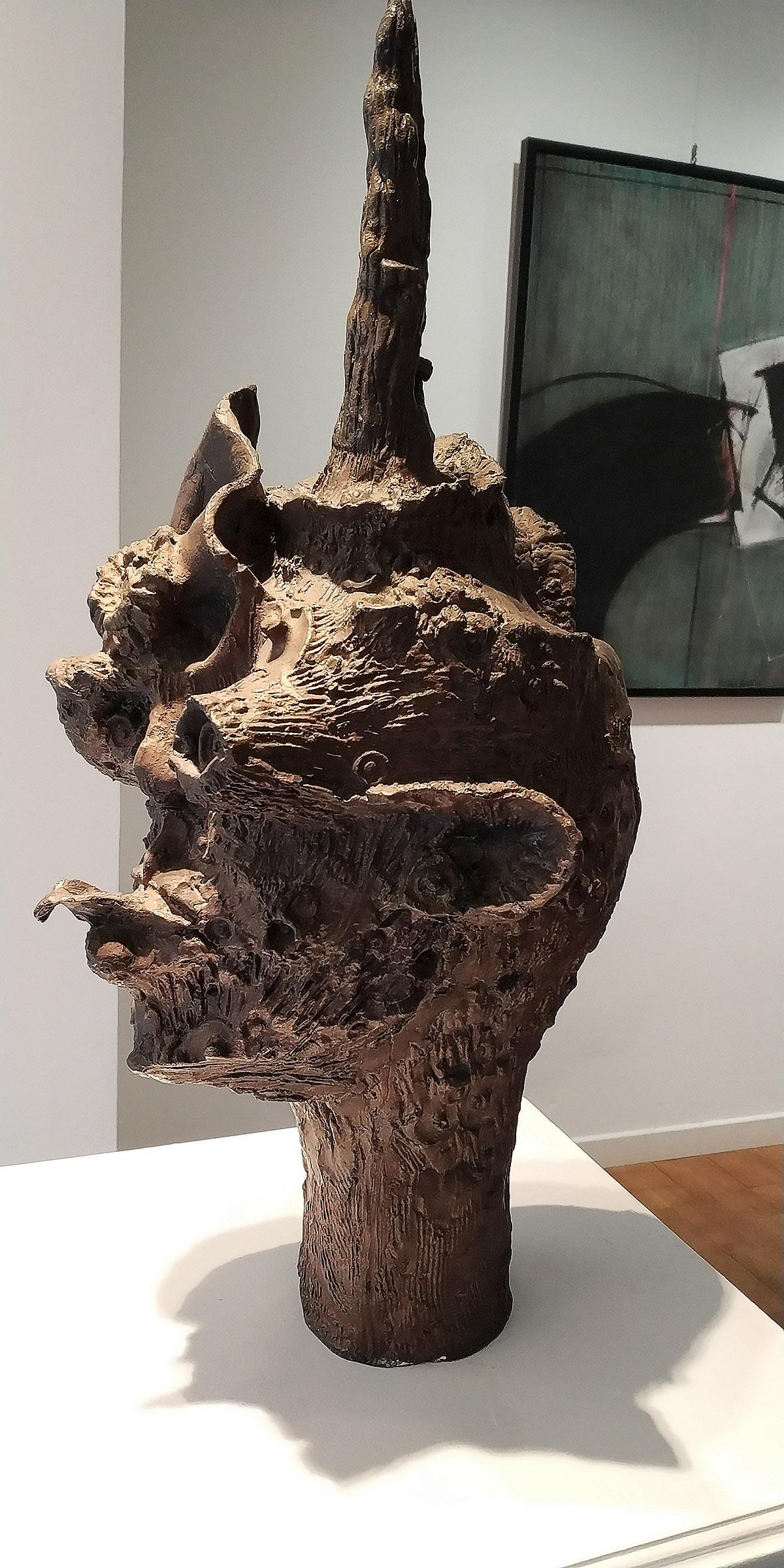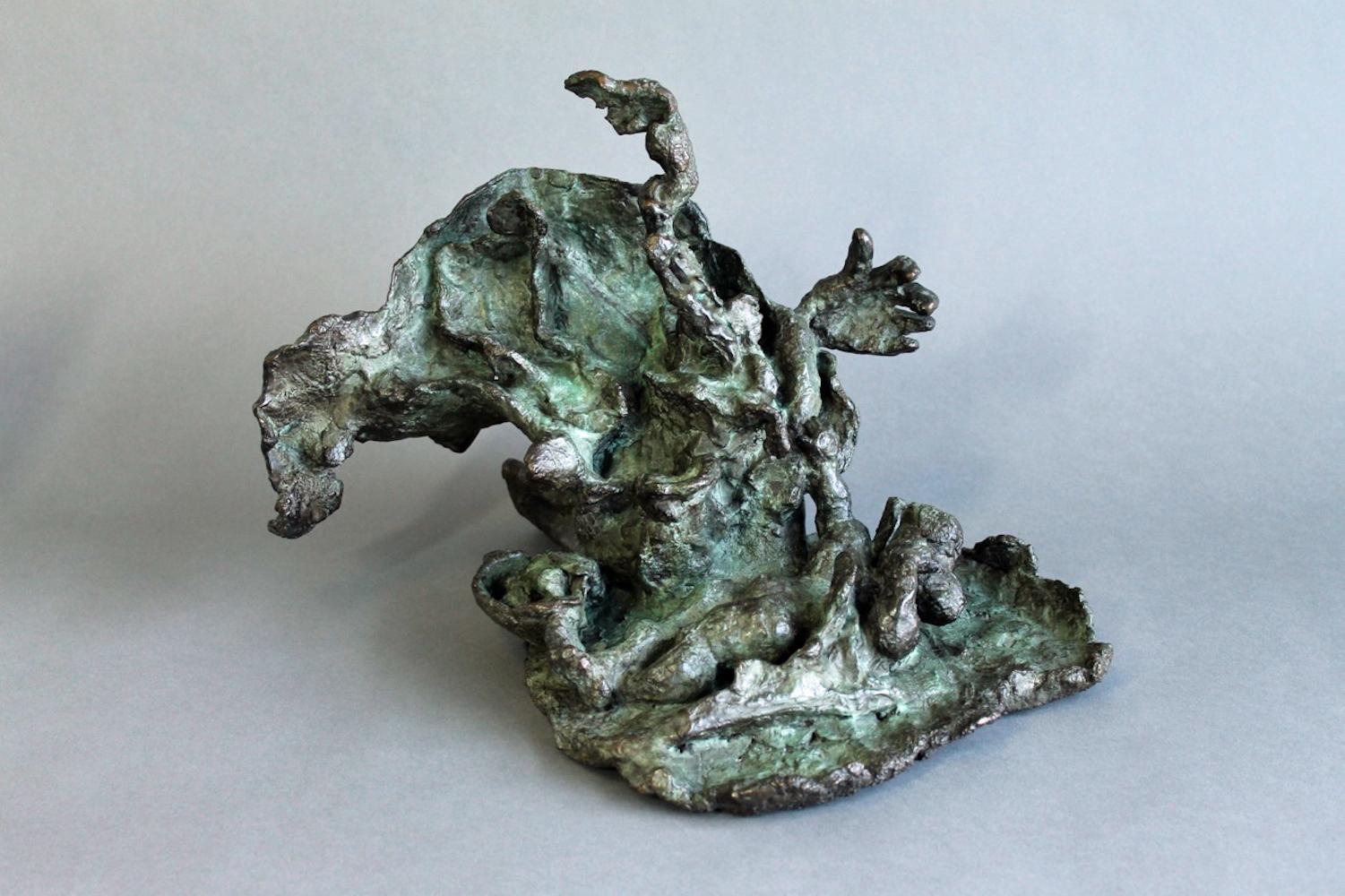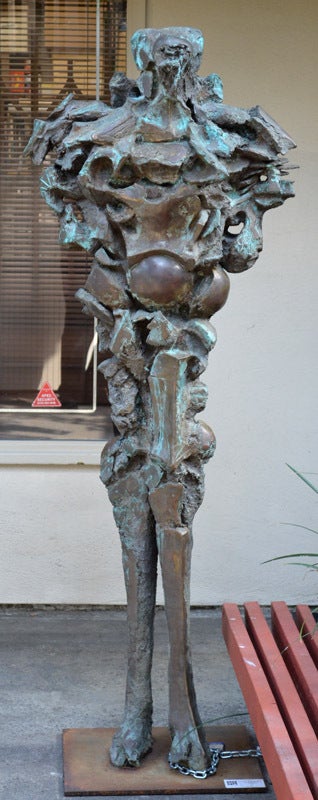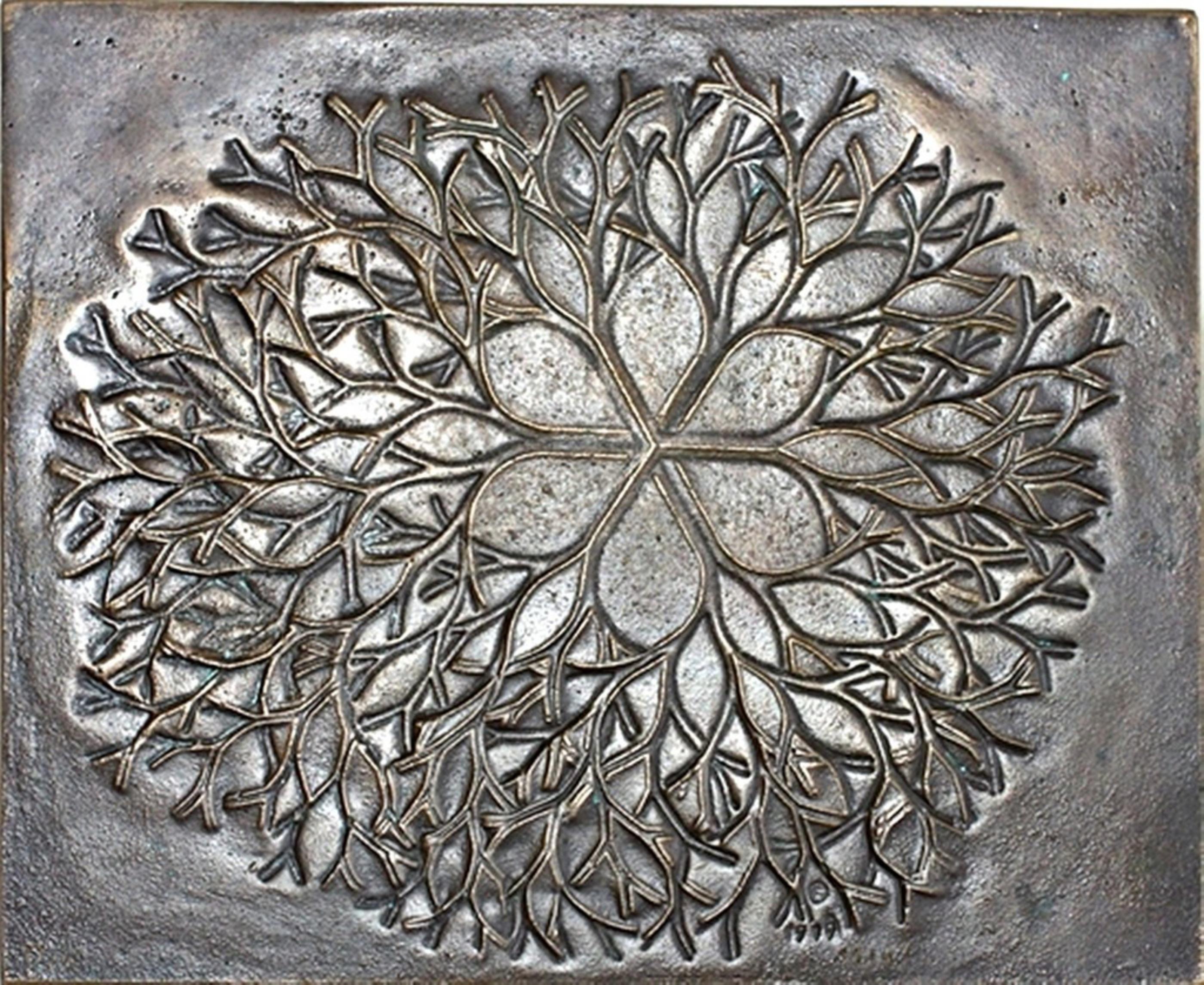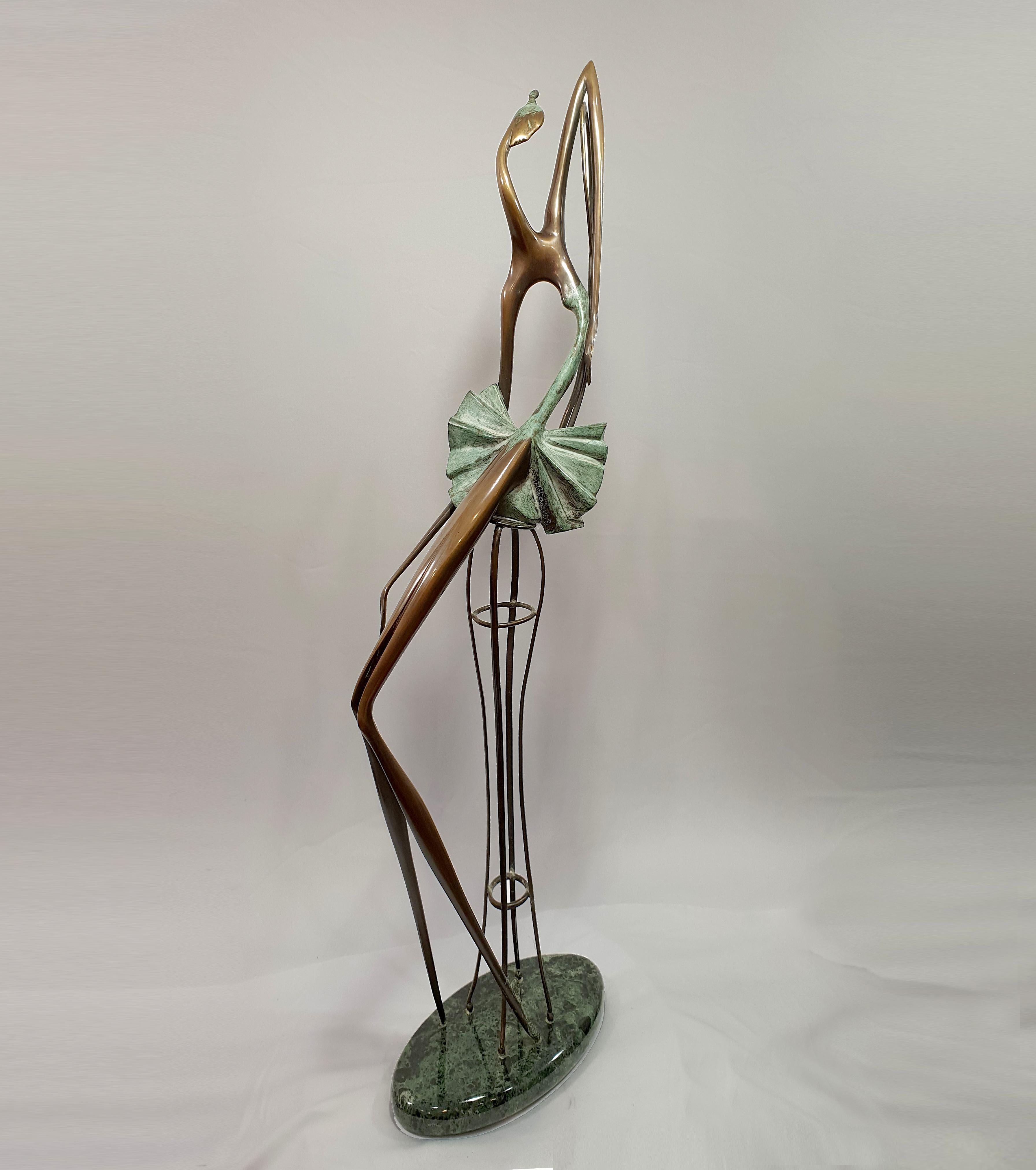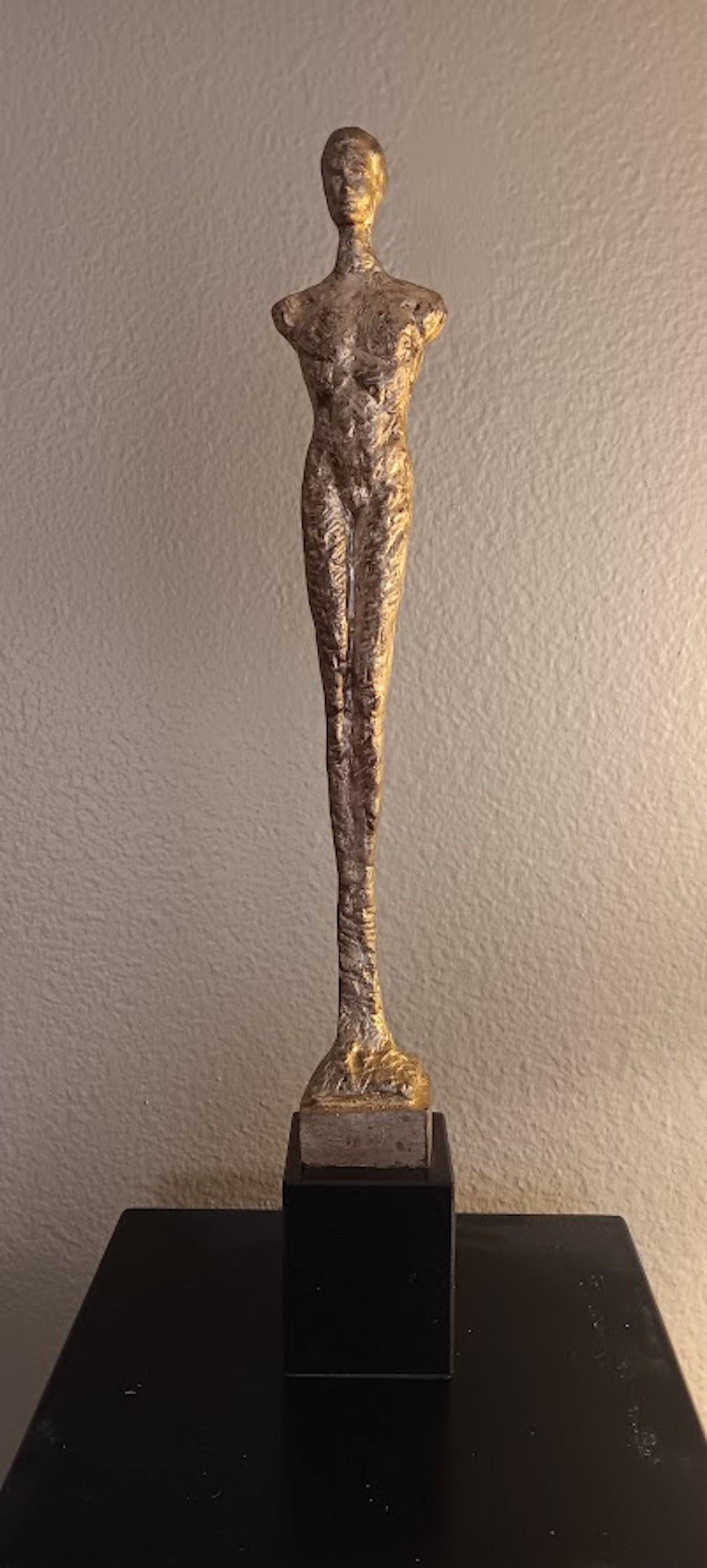Items Similar to Canopo - Bronze Sculpture with Secret Compartments, Funerary Urn, Antropomorphic
Want more images or videos?
Request additional images or videos from the seller
1 of 6
Angelo CanevariCanopo - Bronze Sculpture with Secret Compartments, Funerary Urn, Antropomorphic1990s
1990s
About the Item
Angelo Canevari's "Canopo" is a 22 x 12-inch bronze anthropomorphic sculpture. It is part of the "Canopo" series. With a modern interpretation, Canevari revisited the sacred vases of the ancient Etruscan civilization from the regions of Tuscany and Umbria in Italy. The Etruscans were a polytheistic civilization that believed that all visible phenomena were a manifestation of divine power. Canevari interprets the theme's secrecy and mysteriousness in this monumental yet intimate piece. The sculpture's curved anthropomorphic and totemic shape opens into a magical inside, hiding more secrets and sacred objects. The two sides open like embracing arms, revealing a bronze triangular medallion.
Angelo Canevari is an Italian sculptor from a long lineage of artists active in Rome since the 17th century. He has been commissioned by the Vatican to do several works, including the Bronze Doors of the Cathedral of Belluno and the Vatican Coins.
Related Keywords: Italian Artist, Bronze Sculpture, Etruscan, Mythology, Funerary Art
- Creator:Angelo Canevari (Italian)
- Creation Year:1990s
- Dimensions:Height: 22.5 in (57.15 cm)Width: 12 in (30.48 cm)Depth: 12 in (30.48 cm)
- Medium:
- Movement & Style:
- Period:
- Condition:
- Gallery Location:New York, NY
- Reference Number:1stDibs: LU24921749063
About the Seller
5.0
Vetted Seller
These experienced sellers undergo a comprehensive evaluation by our team of in-house experts.
Established in 2013
1stDibs seller since 2015
73 sales on 1stDibs
Typical response time: 1 hour
- ShippingRetrieving quote...Ships From: Amelia, Italy
- Return PolicyA return for this item may be initiated within 3 days of delivery.
More From This SellerView All
- Canopo - Anthropomorphic Bronze Sculpture with Opening ElementsBy Angelo CanevariLocated in New York, NYThis bronze anthropomorphic sculpture is part of the "Canopo" series. With a modern interpretation, Canevari revisited the sacred vases of the ancient Etruscan civilization from the regions of Tuscany and Umbria in Italy. The Etruscans were a polytheistic civilization that believed that all visible phenomena were a manifestation of divine power. Canevari interprets the theme's secrecy and mysteriousness in this monumental yet intimate piece. The curved anthropomorphic and totemic shape of the sculpture opens into a magical inside, hiding more secrets and sacred objects. The two sides open like embracing arms, revealing a star-shaped medallion and a glass pendulum. The use of rings and solid bronze blocks hanging and protruding from the surface creates a theatrical play of light and shadows. Angelo Canevari is an Italian sculptor from a long lineage of artists active in Rome since the 17th century. He has been commissioned several works by the Vatican, including the Bronze Doors of the Cathedral of Belluno and the Vatican Coins...Category
1990s Contemporary Figurative Sculptures
MaterialsBronze
- Canopo - Anthropomorphic Bronze Sculpture with opening ElementsBy Angelo CanevariLocated in New York, NYAngelo Canevari's "Canopo" is a 22 x 12-inch bronze anthropomorphic sculpture. It is part of the "Canopo" series. With a modern interpretation, Canevari revisited the sacred vases of...Category
1990s Contemporary Figurative Sculptures
MaterialsBronze
- Inclusion 3By Justin PeyserLocated in New York, NYJustin Peyser was graduated from Harvard's Department of Visual and Environmental Studies at a time when it was under the cultural influence of the Bauhaus. His teachers included Gre...Category
2010s Abstract Abstract Sculptures
MaterialsSteel
- Inclusion 2By Justin PeyserLocated in New York, NYJustin Peyser was graduated from Harvard's Department of Visual and Environmental Studies at a time when it was under the cultural influence of the Bauhaus. His teachers included Gre...Category
2010s Abstract Abstract Sculptures
MaterialsSteel
- Territory 2By Justin PeyserLocated in New York, NYJustin Peyser was graduated from Harvard's Department of Visual and Environmental Studies at a time when it was under the cultural influence of the Bauhaus. His teachers included Gre...Category
2010s Contemporary Abstract Sculptures
MaterialsSteel
- Inclusion 6By Justin PeyserLocated in New York, NYJustin Peyser was graduated from Harvard's Department of Visual and Environmental Studies at a time when it was under the cultural influence of the Bauhaus. His teachers included Gre...Category
2010s Abstract Abstract Sculptures
MaterialsSteel
You May Also Like
- Unicorn - bronze sculpture - Salvador Aulestia (1915-1994)Located in Milano, MI"TERAPHIM" Salvador Aulestia's Teraphim exhibition and simultaneous video presentation of the Teraphim exhibition held in front of Leonardo da Vinci's "Last Supper" on Corso Magenta...Category
1970s Modern Figurative Sculptures
MaterialsBronze
- Woman Reclined bronze sculpture by Yulla LipchitzLocated in Hudson, NYOrganic, abstract bronze sculpture by Yulla Lipchitz of a reclined woman. About this artist: Yulla Lipchitz, née Halberstadt, was born on April 21, 1911 in Berlin, Germany. While g...Category
1970s Modern Figurative Sculptures
MaterialsBronze
- Walking ManBy Maxine Kim Stussy 1Located in West Hollywood, CAMaxine Kim Stussy, a prolific sculptor and painter from the late 1940’s to present. Maxine led an incredibly artistic life traveling the world with h...Category
1970s Modern Figurative Sculptures
MaterialsBronze
- Bronze Flower Sculpture PlaqueBy Ruth AsawaLocated in New York, NYRuth Asawa Bronze Flower, 1979 Cast Bronze relief plaque with original presentation box 5 1/4 × 6 1/4 × 1/4 inches Numbered from the Edition of 2500 Signed and dated 'Asawa 1979' (lower edge) incised in the bronze; numbered; stamped "Designed Exclusively for Crown Zellerbach Corporation"; foundry copyright Cast at the Berkley Arts Foundry for Crown Zellerbach Ruth Asawa's estate is represented by David Zwirner. Unframed This beautiful, limited edition signed cast bronze flower plaque makes a distinctive and original gift! It bears the artist's incised signature and is uniquely numbered from the limited edition of 2500. In 1979, the Crown Zellerbach Corporation of San Francisco, which had worked closely with her on neighborhood arts programs, commissioned Asawa to make a series of bronze bas-relief plaques, including this beautiful piece, which were cast by the Berkeley Arts Foundry. Cast at Berkley Arts Foundry for Crown Zellerbach Another example of this work was exhibited in the show "On Black Mountain: The Bauhaus Legacy in America", April 5, 2019-April 27, 2019 at the Sager Braudis Gallery in Columbia, Missouri. It is reproduced on page 13 of the exhibition catalogue. Ruth Asawa Biography American artist, educator, and arts activist Ruth Asawa (1926-2013) is known for her extensive body of wire sculptures that challenge conventional notions of material and form through their emphasis on lightness and transparency. Born in rural California, Asawa was first exposed to professional artists while her family and other Japanese Americans were detained at Santa Anita, California, in 1942. Following her release from an internment camp in Rohwer, Arkansas, eighteen months later, she enrolled in 1943 in Milwaukee State Teachers College. Unable to receive her degree due to continued hostility against Japanese Americans, Asawa left Milwaukee in 1946 to study at Black Mountain College in North Carolina, then known for its progressive pedagogical methods and avant-garde aesthetic environment. Asawa's time at Black Mountain proved formative in her development as an artist, and she was particularly influenced by her teachers Josef Albers, Buckminster Fuller, and the mathematician Max Dehn. She also met architectural student Albert Lanier, whom she would marry in 1949 and with whom she would raise a large family and build a career in San Francisco. Asawa continued to produce art steadily over the course of more than a half century, creating a cohesive body of sculptures and works on paper that, in their innovative use of material and form, deftly synthesizes a wide range of aesthetic preoccupations at the heart of postwar art in America. Asawa’s work has been exhibited widely since the early 1950s, including early solo exhibitions at Peridot Gallery, New York in 1954, 1956, and 1958. In 1965, Walter Hopps organized a solo exhibition of the artist’s sculptures and drawings at the Pasadena Art Museum (now Norton Simon Museum) in California, where Asawa completed a residency at the Tamarind Lithography Workshop the same year. Other solo presentations include those held at the San Francisco Museum of Art (1973); Fresno Art Museum, California (2001; traveled to Oakland Museum of California, 2002); de Young Museum, San Francisco (2006); Amon Carter Museum of American Art, Fort Worth, Texas (2012); and Norton Simon Museum of Art, Pasadena, California (2014). In 2018 to 2019, the Pulitzer Arts Foundation in St. Louis presented Ruth Asawa: Life’s Work, the first major museum exhibition of the artist’s work in more than a decade. An accompanying catalogue published by Pulitzer Arts Foundation and Yale University Press includes essays by Aruna D’Souza, Helen Molesworth, and Tamara H. Schenkenberg. The two-person exhibition, Lineage: Paul Klee and Ruth Asawa was on view at the San Francisco Museum of Modern Art in 2021. In 2022, Ruth Asawa: Citizen of the Universe was on view at Modern Art Oxford, England, and later traveled to the Stavanger Kunstmuseum, Norway. Opening September 16, 2023 at the Whitney Museum of American Art, New York is Ruth Asawa: Through Line, a solo presentation which will later travel to the Menil Drawing Institute in Houston. The artist’s works have also been included in significant group exhibitions, including Leap Before You Look: Black Mountain College 1933–1957, Institute of Contemporary Art, Boston (2015; traveled to Hammer Museum, Los Angeles, and Wexner Center for the Arts, Columbus, Ohio, 2016-2017); America Is Hard to See, Whitney Museum of American Art, New York (2015); Revolution in the Making: Abstract Sculpture by Women, 1947–2016, Hauser & Wirth, Los Angeles (2017); Making Space: Women Artists and Postwar Abstraction, The Museum of Modern Art, New York (2017); The Pencil Is a Key: Drawings by Incarcerated Artists, The Drawing Center, New York (2019); and In a Cloud, in a Wall, in a Chair: Six Modernists in Mexico at Midcentury, Art Institute of Chicago (2019). A selection of the artist's work was presented at the 59th Venice Biennale, The Milk of Dreams (2022). In addition to her wire sculptures, Asawa is well known for her public commissions, particularly in San Francisco and the wider Bay Area. These include the much beloved Andrea fountain in Ghirardelli Square (1966-1968) and the San Francisco Fountain outside the Grand Hyatt Union Square (1970-1973), the latter of which includes hundreds of baker’s clay images molded by local schoolchildren, friends, and other artists cast...Category
Mid-20th Century Modern Abstract Sculptures
MaterialsBronze
- Ballerina on a chairLocated in Sempach, LUSculpture from the Ballet series. The series is dedicated to classical ballet and includes over 30 sculptures. This sculpture depicts a dancer tying p...Category
Early 2000s Modern Figurative Sculptures
MaterialsMarble, Metal, Bronze
- After Alberto Giacometti, Man Standing Up, Bronze FigureBy Alberto GiacomettiLocated in Pasadena, CAModern bronze with gold patina figural sculpture, in the style of Alberto Giacometti (Swiss, 1901-1966), not signed, depicting abstract nude male a figures, in a parcel gilt finish, ...Category
1950s Modern Figurative Sculptures
MaterialsBronze
